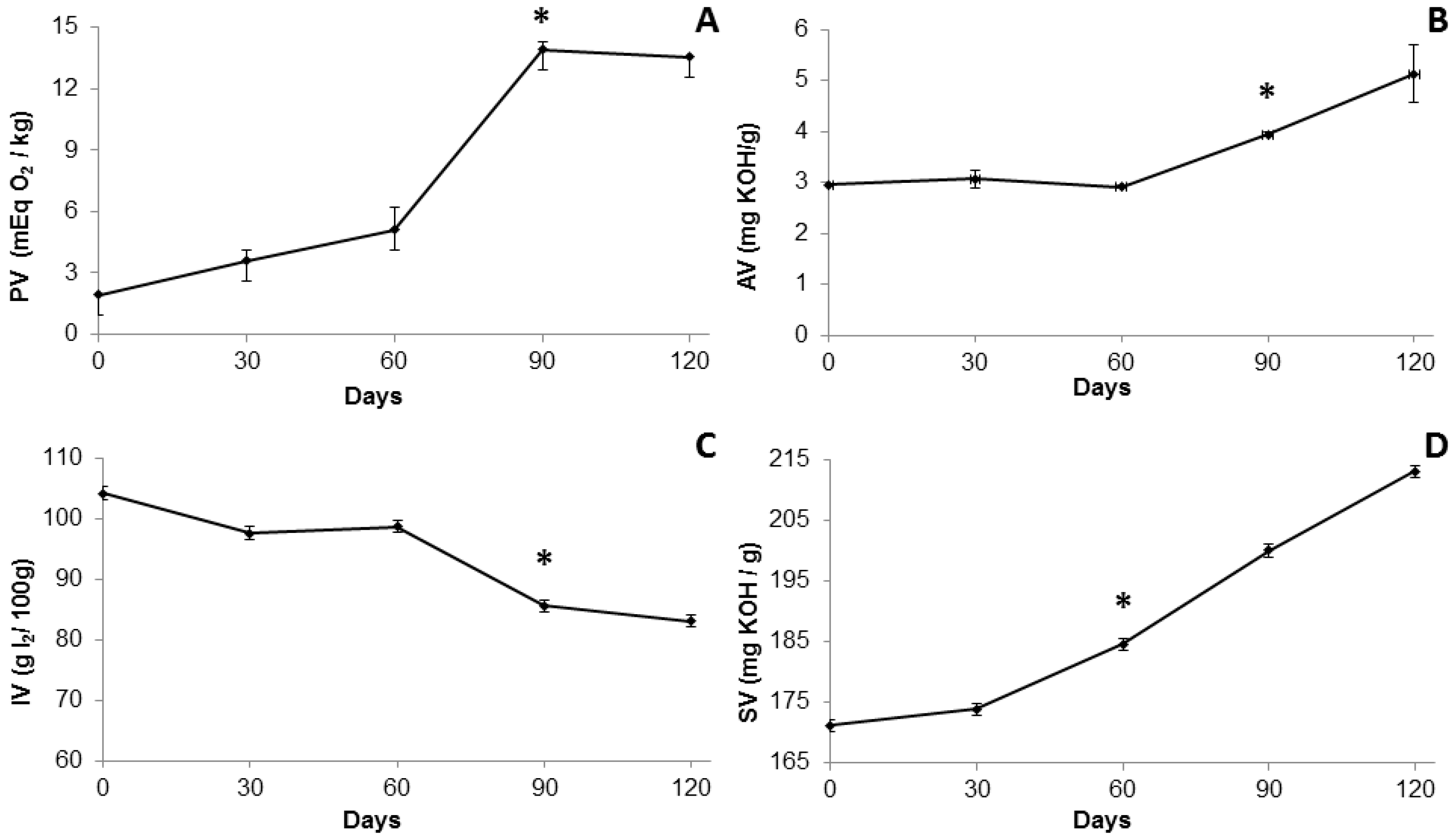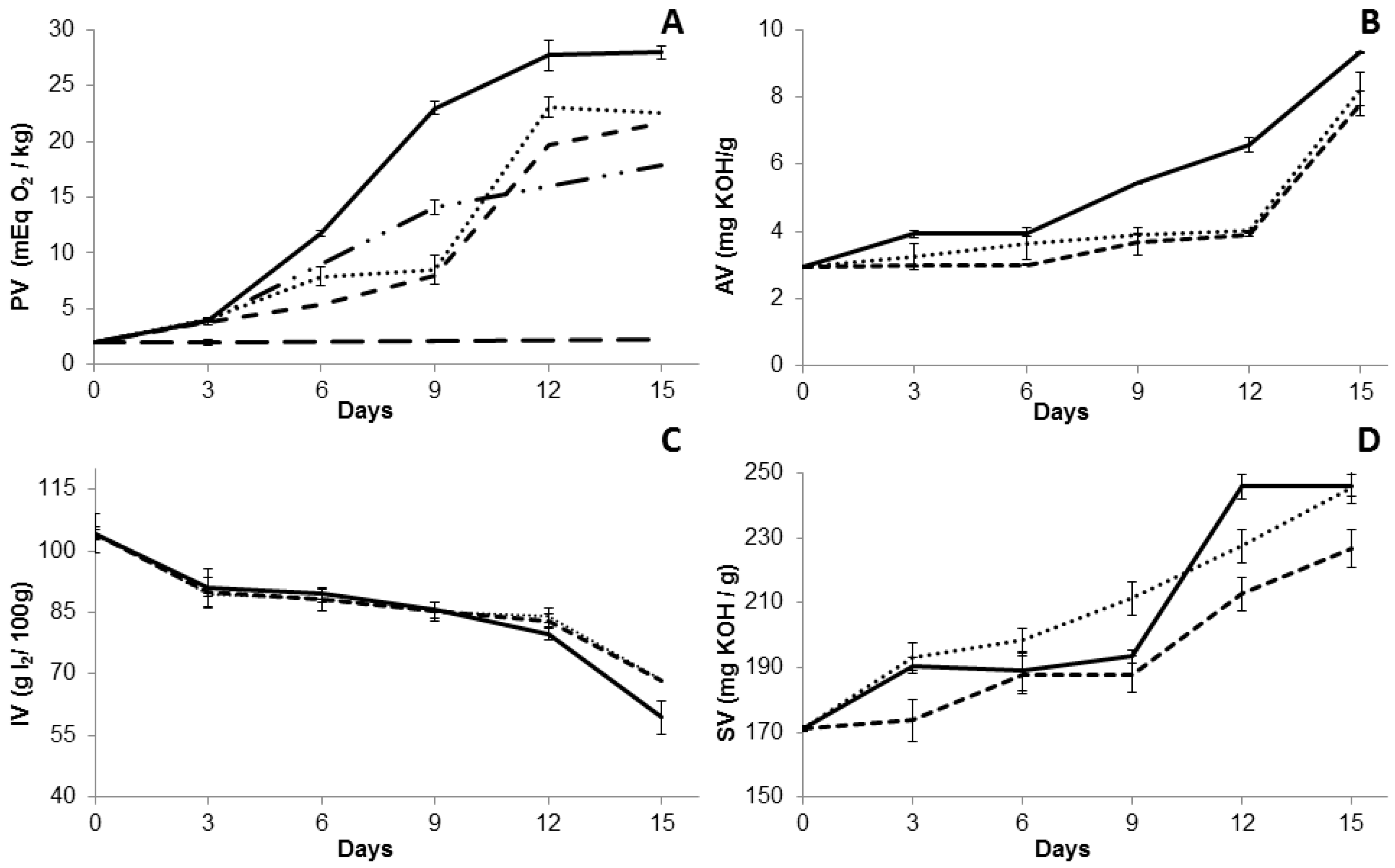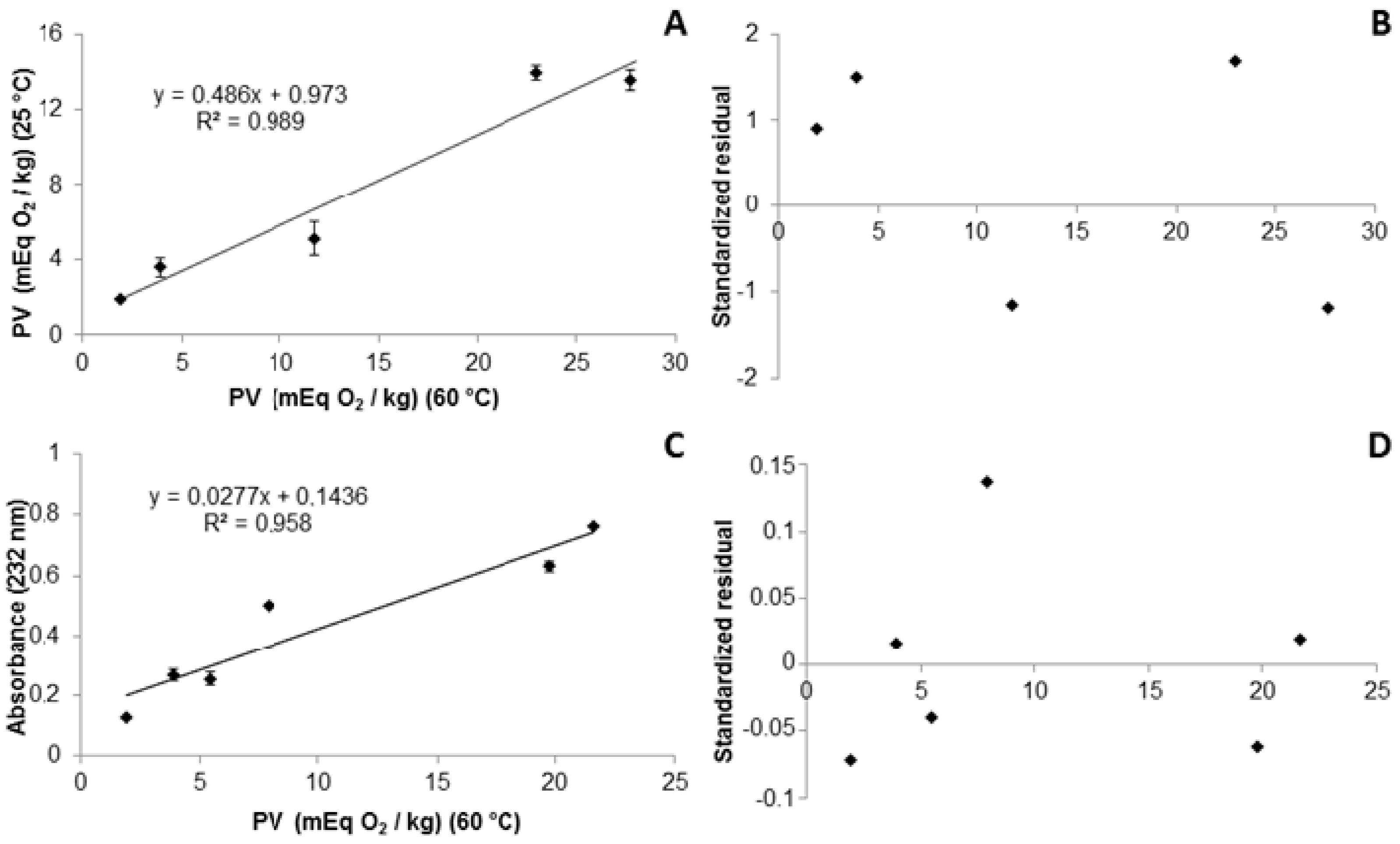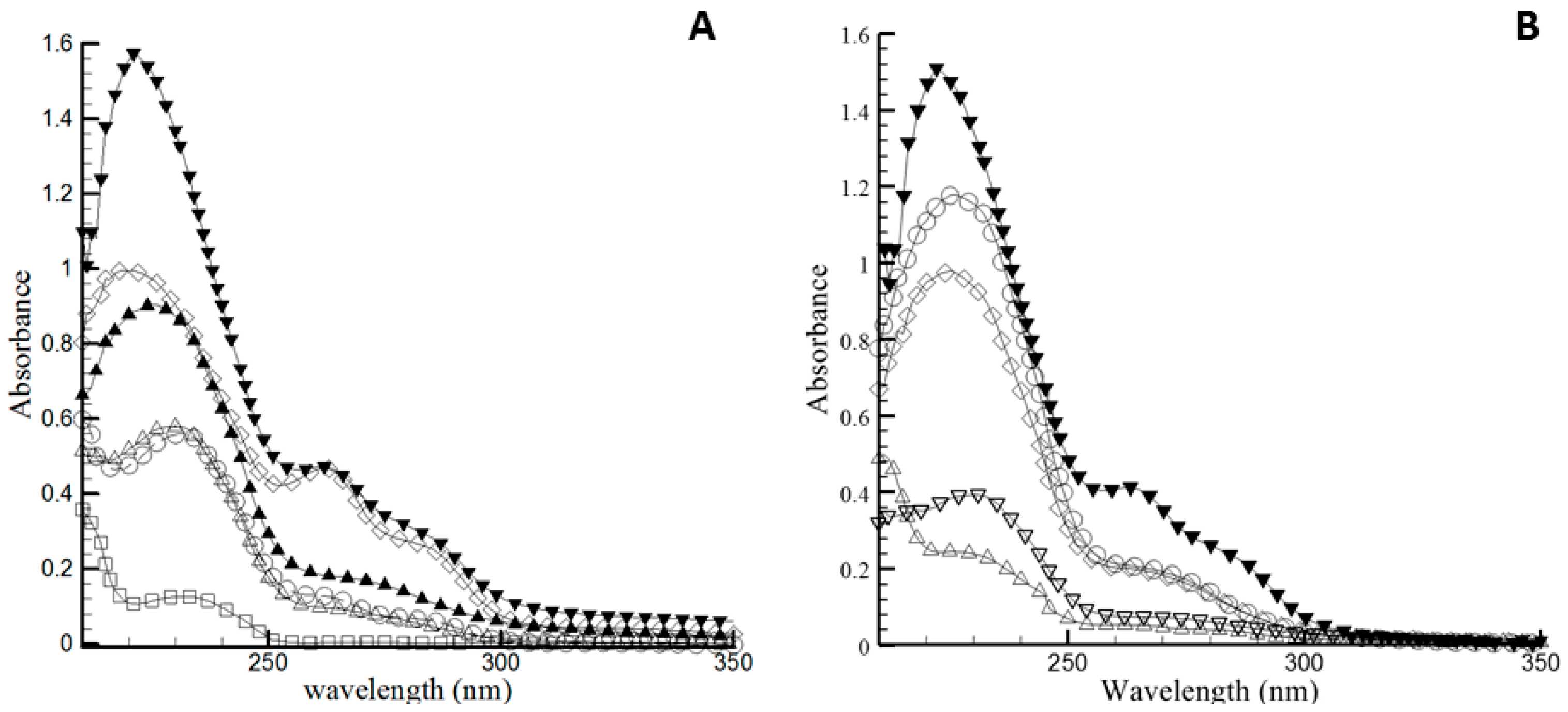Thermo-Oxidative Stability Evaluation of Bullfrog (Rana catesbeiana Shaw) Oil
Abstract
:1. Introduction
2. Results and Discussion
2.1. Extraction and Physicochemical Characterization of Bullfrog Oil
2.2. Accelerated Oxidative Stability of Bullfrog Oil
2.2.1. Physicochemical Changes
2.2.2. Conjugated Dienes and Trienes
2.2.3. Rancimat®
2.2.4. Fourier Transform Infrared Spectroscopy Analysis
2.2.5. Thermal and Oxidative Stability
3. Materials and Methods
3.1. Materials
3.2. Bullfrog Oil Extraction
3.3. Physicochemical Characterization of Bullfrog Oils
3.3.1. Peroxide, Acid, Iodine and Saponification Values
3.3.2. Organoleptic Characteristics
3.3.3. Refractive Index
3.4. Chemical Characterization of Bullfrog Oil
3.5. Oxidative Stability of the Bullfrog Oil
3.5.1. Preparation of Bullfrog Oil Samples
3.5.2. Conjugated Dienes and Trienes
3.5.3. Rancimat®
3.5.4. Fourier Transforms Infrared Spectroscopy
3.6. Thermal Stability of Bullfrog Oil
3.7. Statistical Analyses
4. Conclusions
Acknowledgments
Author Contributions
Conflicts of Interest
References
- Cragg, G.M.; Newman, D.J. Natural products: A continuing source of novel drug leads. Biochim. Biophys. Acta 2013, 1830, 3670–3695. [Google Scholar] [CrossRef] [PubMed]
- Alves, R.R.N.; Rosa, I.L. Why study the use of animal products in traditional medicines? J. Ethnobiol. Ethnomed. 2005, 1, 1–5. [Google Scholar]
- Lopes, V.S.; Dantas, T.N.C.; Cunha, A.F.; Moura, E.F.; Maciel, M.A.M. A new anionic surfactant obtained from Rana catesbeiana SHAW. Rev. Univ. Rural 2010, 30, 85–97. [Google Scholar]
- Nóbrega, I.C.C.; Ataíde, C.S.; Moura, O.M.; Livera, A.V.; Menezes, P.H. Volatile constituents of cooked bullfrog (Rana catesbeiana) legs. Food Chem. 2007, 102, 186–191. [Google Scholar] [CrossRef]
- Machado, L.A.; Xavier-Júnior, F.H.; Rutckeviski, R.; Morais, A.R.V.; Alencar, É.N.; Dantas, T.R.F.; Cruz, A.K.M.; Genre, J.; Silva-Junior, A.A.; Pedrosa, M.F.F.; et al. New trends on antineoplastic therapy research: Bullfrog (Rana catesbeiana Shaw) oil nanostructured systems. Molecules 2016, 21, 585. [Google Scholar] [CrossRef] [PubMed]
- Rapoport, S.I.; Ramadan, E.; Basselin, M. Docosahexaenoic acid (DHA) incorporation into the brain from plasma, as an in vivo biomarker of brain DHA metabolism and neurotransmission. Prostaglandins Other Lipid Mediat. 2011, 96, 109–113. [Google Scholar] [CrossRef] [PubMed]
- Kelley, D.S. Modulation of human immune and inflammatory responses by dietary fatty acids. Nutrition 2001, 17, 669–673. [Google Scholar] [CrossRef]
- Alencar, E.N.; Xavier-Junior, F.H.; Morais, A.R.; Dantas, T.R.; Dantas-Santos, N.; Verissimo, L.M.; Rehder, V.L.; Chaves, G.M.; Oliveira, A.G.; Egitol, E.S. Chemical characterization and antimicrobial activity evaluation of natural oil nanostructured emulsions. J. Nanosci. Nanotechnol. 2015, 15, 880–888. [Google Scholar] [CrossRef] [PubMed]
- Atarés, L.; Marshall, L.J.; Akhtar, M.; Murray, B.S. Structure and oxidative stability of oil in water emulsions as affected by rutin and homogenization procedure. Food Chem. 2012, 134, 1418–1424. [Google Scholar] [CrossRef] [PubMed]
- Guillén, M.D.; Ruiz, A. Formation of hydroperoxy- and hydroxyalkenals during thermal oxidative degradation of sesame oil monitored by proton NMR. Eur. J. Lipid Sci. Technol. 2004, 106, 680–687. [Google Scholar] [CrossRef]
- Menegazzo, M.L.; Petenuci, M.E.; Fonseca, G.G. Production and characterization of crude and refined oils obtained from the co-products of Nile tilapia and hybrid sorubim processing. Food Chem. 2014, 157, 100–104. [Google Scholar] [CrossRef] [PubMed]
- Huang, J.; Sathivel, S. Thermal and rheological properties and the effects of temperature on the viscosity and oxidation rate of unpurified salmon oil. J. Food Eng. 2008, 89, 105–111. [Google Scholar] [CrossRef]
- Martínez-Yusta, A.; Goicoechea, E.; Guillén, M.D. A review of thermo-oxidative degradation of food lipids studied by 1H NMR spectroscopy: Influence of degradative conditions and food lipid nature. Compre. Rev. Food Sci. Food Saf. 2014, 13, 838–859. [Google Scholar] [CrossRef]
- Ramalho, V.C.; Jorge, N. Antioxidants used in oils, fats and fatty foods. Quim. Nova 2006, 29, 755–760. [Google Scholar]
- Nonviho, G.; Paris, C.; Muniglia, L.; Sohounhloué, D.; Brosse, N. Lophira lanceolata seed oil extraction method (ancestral or modern) modifies the properties of the oil. Ind. Crops Prod. 2015, 67, 49–54. [Google Scholar] [CrossRef]
- Méndez, E.; Sanhueza, J.; Nieto, S.; Speisky, H.; Valenzuela, A. Fatty acid composition, extraction, fractionation, and stabilization of bullfrog (Rana catesbeiana) oil. J. Am. Oil Chem. Soc. 1998, 75, 79–83. [Google Scholar] [CrossRef]
- Bimbo, A.P. Guidelines for characterising food grade fish oil. IFOMA 1998, 9, 473–483. [Google Scholar]
- Kaczmarski, M.; Cudowska, B.; Sawicka-Żukowska, M.; Bobrus-Chociej, A. Supplementation with long chain polyunsaturated fatty acids in treatment of atopic dermatitis in children. Postepy Dermatol. Alergol. 2013, 30, 103–107. [Google Scholar] [CrossRef] [PubMed]
- Codex, Codex Alimentarius Commission. Report of the Fourteenth Session of the Codex Committee on Fats and Oils; Codex, Codex Alimentarius Commission: London, UK, 1993; p. 105. [Google Scholar]
- Rodrigues, J.; Miranda, I.; Furquim, L.; Gominho, J.; Vasconcelos, M.; Barradas, G.; Pereira, H.; Bianchi-de-Aguiar, F.; Ferreira-Dias, S. Storage stability of Jatropha curcas L. oil naturally rich in gamma-tocopherol. Ind. Crops Prod. 2015, 64, 188–193. [Google Scholar] [CrossRef]
- Immanuel, G.; Sathasivan, S.; Shankar, V.S.; Peter, M.J.P.; Palavesam, A. Processing and characterisation of low cost Balistid fish Sufflamen capistratus liver oil for edible purpose. Food Chem. 2009, 115, 430–435. [Google Scholar] [CrossRef]
- Adeoti, I.A.; Hawboldt, K. A review of lipid extraction from fish processing by-product for use as a biofuel. Biomass Bioenergy 2014, 63, 330–340. [Google Scholar] [CrossRef]
- Anjum, F.; Anwar, F.; Jamil, A.; Iqbal, M. Microwave roasting effects on the physico-chemical composition and oxidative stability of sunflower seed oil. J. Am. Oil Chem. Soc. 2006, 83, 777–784. [Google Scholar] [CrossRef]
- Nyakudya, T.T.; Nosenga, N.; Chivandi, E.; Erlwanger, K.H.; Gundidza, M.; Gundidza, E.; Magwa, M.L.; Muredzi, P. Grewia bicolor seed oil: Putative pharmaceutical, cosmetic and industrial uses. S. Afr. J. Bot. 2015, 97, 154–158. [Google Scholar] [CrossRef]
- Berset, C.; Cuvelier, M.E. Méthodes d’évaluation du degré d’oxydation des lipides et de mesure du pouvoir antioxydant. Sci. Aliments 1996, 16, 219–245. [Google Scholar]
- Serfert, Y.; Drusch, S.; Schwarz, K. Sensory odour profiling and lipid oxidation status of fish oil and microencapsulated fish oil. Food Chem. 2010, 123, 968–975. [Google Scholar] [CrossRef]
- Uquiche, E.; Jeréz, M.; Ortíz, J. Effect of pretreatment with microwaves on mechanical extraction yield and quality of vegetable oil from Chilean hazelnuts (Gevuina avellana Mol). Innov. Food Sci. Emerg. Technol. 2008, 9, 495–500. [Google Scholar] [CrossRef]
- Silva, F.A.M.; Borges, M.F.M.; Ferreira, M.A. Methods for the evaluation of the degree of lipid oxidation and the antioxidant activity. Quim. Nova 1999, 22, 94–103. [Google Scholar] [CrossRef]
- Zhang, Y.; Yang, L.; Zu, Y.; Chen, X.; Wang, F.; Liu, F. Oxidative stability of sunflower oil supplemented with carnosic acid compared with synthetic antioxidants during accelerated storage. Food Chem. 2010, 118, 656–662. [Google Scholar] [CrossRef]
- Khan, M.A.; Shahidi, F. Effects of natural and synthetic antioxidants on the oxidative stability of borage and evening primrose triacylglycerols. Food Chem. 2001, 75, 431–437. [Google Scholar] [CrossRef]
- Sbihi, H.M.; Nehdi, I.A.; Al-Resayes, S.I. Characterization of Hachi (Camelus dromedarius) fat extracted from the hump. Food Chem. 2013, 139, 649–654. [Google Scholar] [CrossRef] [PubMed]
- Iqbal, S.; Bhanger, M.I. Stabilization of sunflower oil by garlic extract during accelerated storage. Food Chem. 2007, 100, 246–254. [Google Scholar] [CrossRef]
- Bakry, A.M.; Fang, Z.; Ni, Y.; Cheng, H.; Chen, Y.Q.; Liang, L. Stability of tuna oil and tuna oil/peppermint oil blend microencapsulated using whey protein isolate in combination with carboxymethyl cellulose or pullulan. Food Hydrocoll. 2016, 60, 559–571. [Google Scholar] [CrossRef]
- Almeida, V.F.; García-Moreno, P.J.; Guadix, A.; Guadix, E.M. Biodiesel production from mixtures of waste fish oil, palm oil and waste frying oil: Optimization of fuel properties. Fuel Process. Technol. 2015, 133, 152–160. [Google Scholar] [CrossRef]
- Guillen, M.D.; Goicoechea, E. Detection of primary and secondary oxidation products by Fourier transform infrared spectroscopy (FTIR) and 1H nuclear magnetic resonance (NMR) in sunflower oil during storage. J. Agric. Food Chem. 2007, 55, 10729–10736. [Google Scholar] [CrossRef] [PubMed]
- Guillén, M.D.; Cabo, N. Some of the most significant changes in the Fourier transform infrared spectra of edible oils under oxidative conditions. J. Sci. Food Agric. 2000, 80, 2028–2036. [Google Scholar] [CrossRef]
- Yahuaca-Juárez, B.; Martínez-Flores, H.E.; Huerta-Ruelas, J.A.; Pless, R.C.; Vázquez-Landaverde, P.A.; Tello Santillán, R. Oil oxidation in corn flour from grains processed with alkaline cooking by use of peroxide value, UV and FTIR. Plant Foods Hum. Nutr. 2013, 68, 65–71. [Google Scholar] [CrossRef] [PubMed]
- Roby, M.H.H.; Castro, V.C.; Targino, B.N.; Silva, P.H.A.; Mangavel, C.; Chretien, F.; Humeau, C.; Desobry, S. Oxidative stability of DHA phenolic ester. Food Chem. 2015, 169, 41–48. [Google Scholar] [CrossRef] [PubMed]
- USP. United States Pharmacopoeial Convention. USP 30-NF 25, 2nd Supplement; USP Convention: Rockville, MD, USA, 2007. [Google Scholar]
- AOCS. Official Methods of Analysis of AOAC International, 19th ed.; AOAC International: Gaithersburg, MD, USA, 2012. [Google Scholar]
- Fernandes, A.R.; Dario, M.F.; Pinto, C.A.S.d.O.; Kaneko, T.M.; Baby, A.R.; Velasco, M.V.R. Stability evaluation of organic Lip Balm. Braz. J. Pharm. Sci. 2013, 49, 293–299. [Google Scholar] [CrossRef]
- Pegg, R.B. Measurement of primary lipid oxidation products. In Current Protocols in Food Analytical Chemistry; John Wiley & Sons, Inc.: Hoboken, NJ, USA, 2001. [Google Scholar]
Sample Availability: Not available. |






| A—Percentage of major fatty acids from extracted bullfrog oil. *compounds where composition was greater than 0.7% of total components. MW: molecular weight, RT (min): Retention time. | |||
| Compound * | MW | RT (min) | Area (%) |
| Myristic acid (14:0) | 300 | 10.35 | 1.4 |
| Palmitoleic acid (16:1) | 326 | 12.06 | 7.7 |
| Palmitic acid (16:0) | 328 | 12.25 | 10.3 |
| Eicosapentanoic acid (20:5 n−3) | 374 | 13.60 | 17.6 |
| Oleic acid (18:1 n−9) | 354 | 13.78 | 30.0 |
| Stearic acid (18:0) | 356 | 14.00 | 2.5 |
| Arachidonic acid (20:4 n−6) | 376 | 15.03 | 0.7 |
| Docosahexaenoic acid (22:6 n−3) | 400 | 16.51 | 0.8 |
| Cholesterol | 458 | 20.62 | 9.5 |
| Ethyl-iso-allocholate | 436 | 27.76 | 3.5 |
| Total | 83.9 | ||
| Not identified | 16.1 | ||
| B—Oxidation induction time (IT) analyses of pure bullfrog oil (BO) performed at 110 °C and after addition of butylhydroxytoluene (BHA) or buthylhydroxyanisole (BHT) antioxidants at minimum (BOAm and BOTm) and maximum (BOAmx and BOTmx) concentrations. | |||
| Sample | IT (h) | ||
| BO | 0.32 ± 0.01 | ||
| BOAm | 0.05 ± 0.01 | ||
| BOAmx | 0.05 ± 0.03 | ||
| BOTm | 0.72 ± 0.02 | ||
| BOTmx | 7.88 ± 0.13 | ||
© 2017 by the authors. Licensee MDPI, Basel, Switzerland. This article is an open access article distributed under the terms and conditions of the Creative Commons Attribution (CC BY) license (http://creativecommons.org/licenses/by/4.0/).
Share and Cite
Rutckeviski, R.; Xavier-Júnior, F.H.; Morais, A.R.V.; Alencar, É.N.; Amaral-Machado, L.; Genre, J.; Gondim, A.D.; Egito, E.S.T. Thermo-Oxidative Stability Evaluation of Bullfrog (Rana catesbeiana Shaw) Oil. Molecules 2017, 22, 606. https://doi.org/10.3390/molecules22040606
Rutckeviski R, Xavier-Júnior FH, Morais ARV, Alencar ÉN, Amaral-Machado L, Genre J, Gondim AD, Egito EST. Thermo-Oxidative Stability Evaluation of Bullfrog (Rana catesbeiana Shaw) Oil. Molecules. 2017; 22(4):606. https://doi.org/10.3390/molecules22040606
Chicago/Turabian StyleRutckeviski, Renata, Francisco H. Xavier-Júnior, Andreza R.V. Morais, Éverton N. Alencar, Lucas Amaral-Machado, Julieta Genre, Amanda D. Gondim, and Eryvaldo S.T. Egito. 2017. "Thermo-Oxidative Stability Evaluation of Bullfrog (Rana catesbeiana Shaw) Oil" Molecules 22, no. 4: 606. https://doi.org/10.3390/molecules22040606







